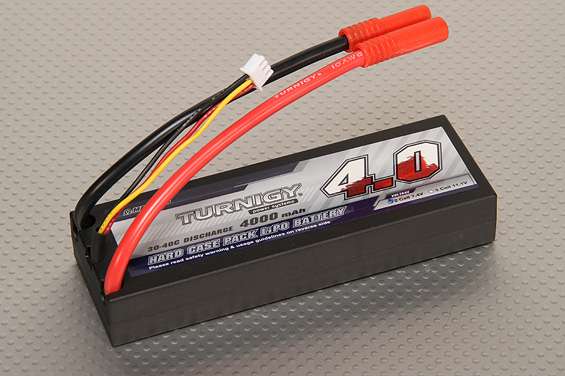If you are looking to improve the performance of your electric RC Car, one of the first things you should do is make sure the car is getting the power it needs. Battery power is something that is often overlooked by beginners to the hobby; if you upgrade your motor and ESC you may not see much difference if the batteries are not up to the job.
If you are still using old style Ni-Cad or Ni-Mh rechargeable batteries you may be in for a surprise when you upgrade to Li-Po! Whether you run an rc buggy, on road race car or truck, you should certainly notice a difference with a Li-po pack.

A turnigy 2s (2 cell) 7.4v rc car battery pack.
What is a Li-Po battery?
Usually abbreviated as LiPo or Li-Poly, the full name is actually a lithium-ion polymer battery. These batteries usually come in either a soft ‘weight saving’ pouch or in a plastic hard case.
Each cell has a nominal voltage of 3.3v – 3.7v as opposed to traditional cylindrical ni-cads with a voltage of around 1.2v – 1.5v. This is why Li-po battery packs have unusual voltages; 3.7v 1 cell (or 1s), 7.4v (2s) and 11.1v (3s) etc, compared to ni-cads with 1.2v per cell and a typical six cell RC ni-cad or ni-mh pack with 7.2v total voltage.
Use of Li-po in RC models
Li-po batteries started becoming available for RC cars and planes in the late nineties and have now really taken over from the old style Ni-cad / Ni-mh batteries. These batteries are being used in more and more devices due to the smaller size, lower weight and extra power they can provide.
The advantages of Li-po batteries in RC
- Lighter weight – a lot lighter! Less weight means a faster car with better acceleration.
- Much more power from the same battery size.
- More punch due to the large currents they can deliver.
And the disadvantages
- Li-po batteries need extra care when charging; they should never be left unattended whilst on charge, and ideally should be placed outside in a garage or shed. No matter where you charge them, always in a fireproof bag/container. While it is rare, these batteries can catch fire if abused.
- These batteries require a Li-Po compatible battery charger, although many modern digital chargers support them.
- Li-po batteries shouldn’t be run until completely drained (like you can with ni-cad/ni-mh) as it will more than likely damage the pack, and you may not be able to get a charge back into it. Most ESC’s will have a cut out feature to prevent over discharging, but it is better if you make a note of your run times so you can charge the pack before this happens.
Store Li-po batteries at 50%, not fully charged.
If you are storing your battery for any extended period you should partially discharge your li-po and ideally keep it in a cool place. Most li-po balance chargers have a ‘storage’ preset which will discharge/charge the battery to the correct level to prolong its life. For example, a 2s 7.4v battery storage charge might be 7.6v (3.8v per cell). You can use a battery checker like ones in the photos below to find out the voltage.

A fully charged li-po typically has around 4.2v per cell, and, according to some battery manufacturers, shouldn’t be discharged below 3.3v per cell. This is the reason most ESC’s have an automatic cut out feature set to this value.
Don’t leave fully charged for extended periods of time
If stored fully charged for too long, the chemical reactions in the battery can reduce its punch and capacity, so store them as described above, then top them up the day or night before you want to use them.
